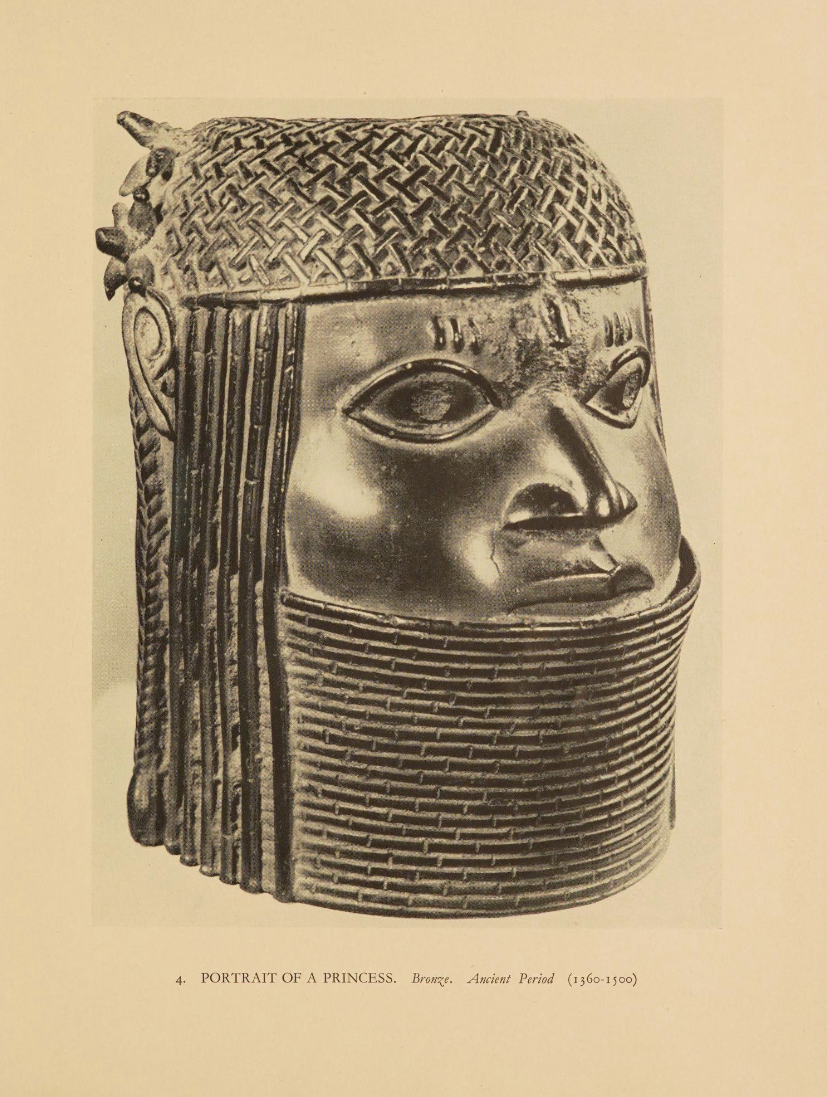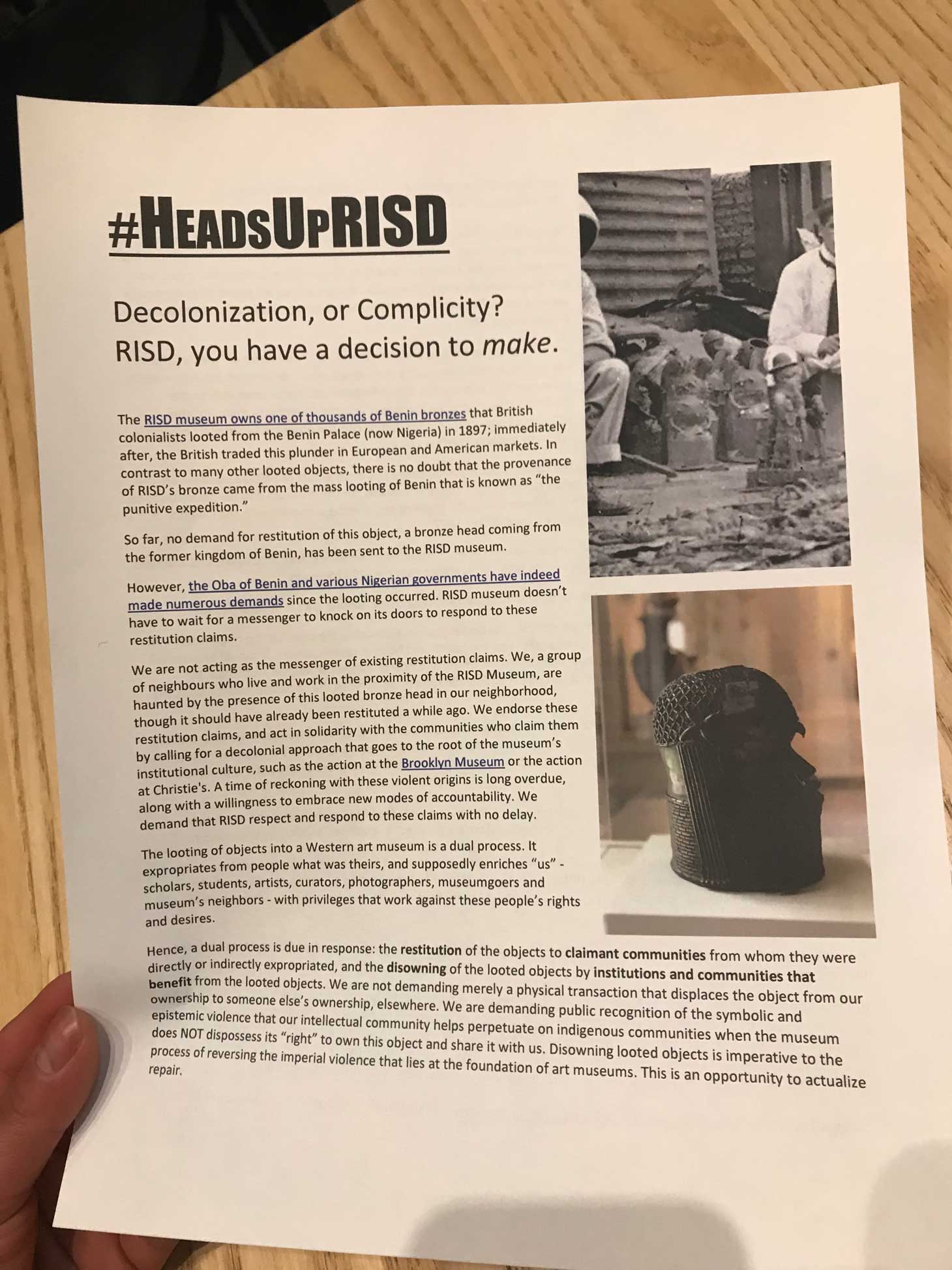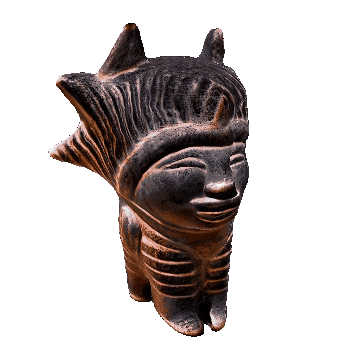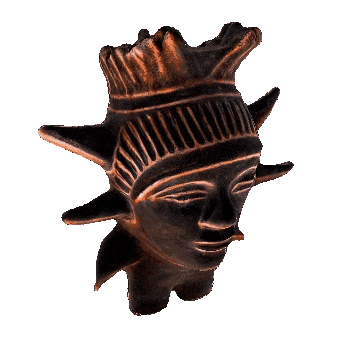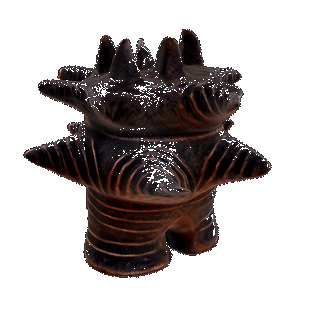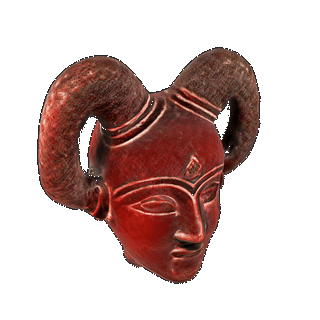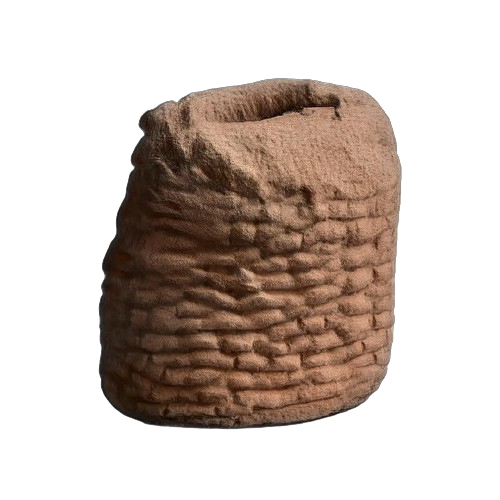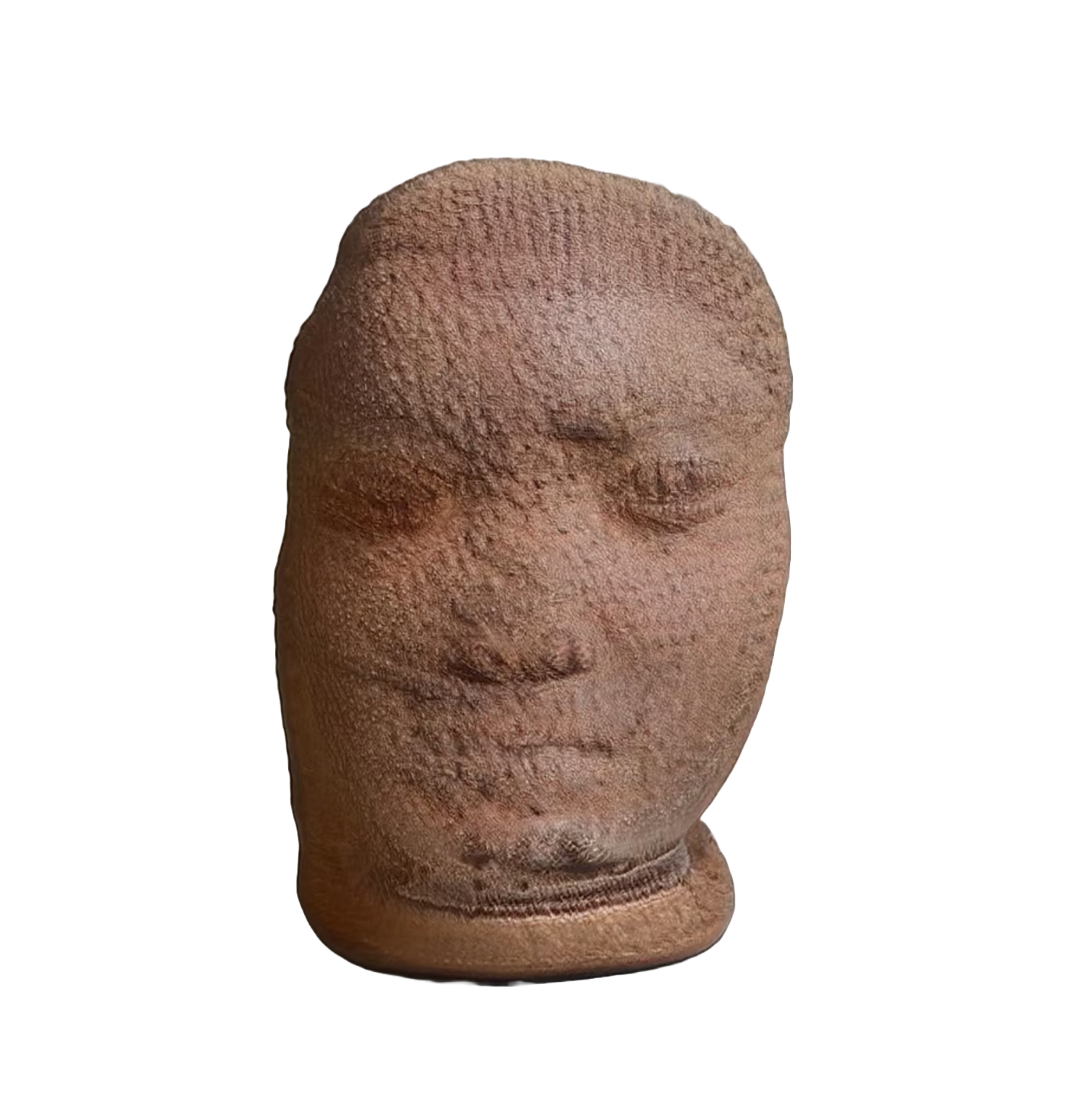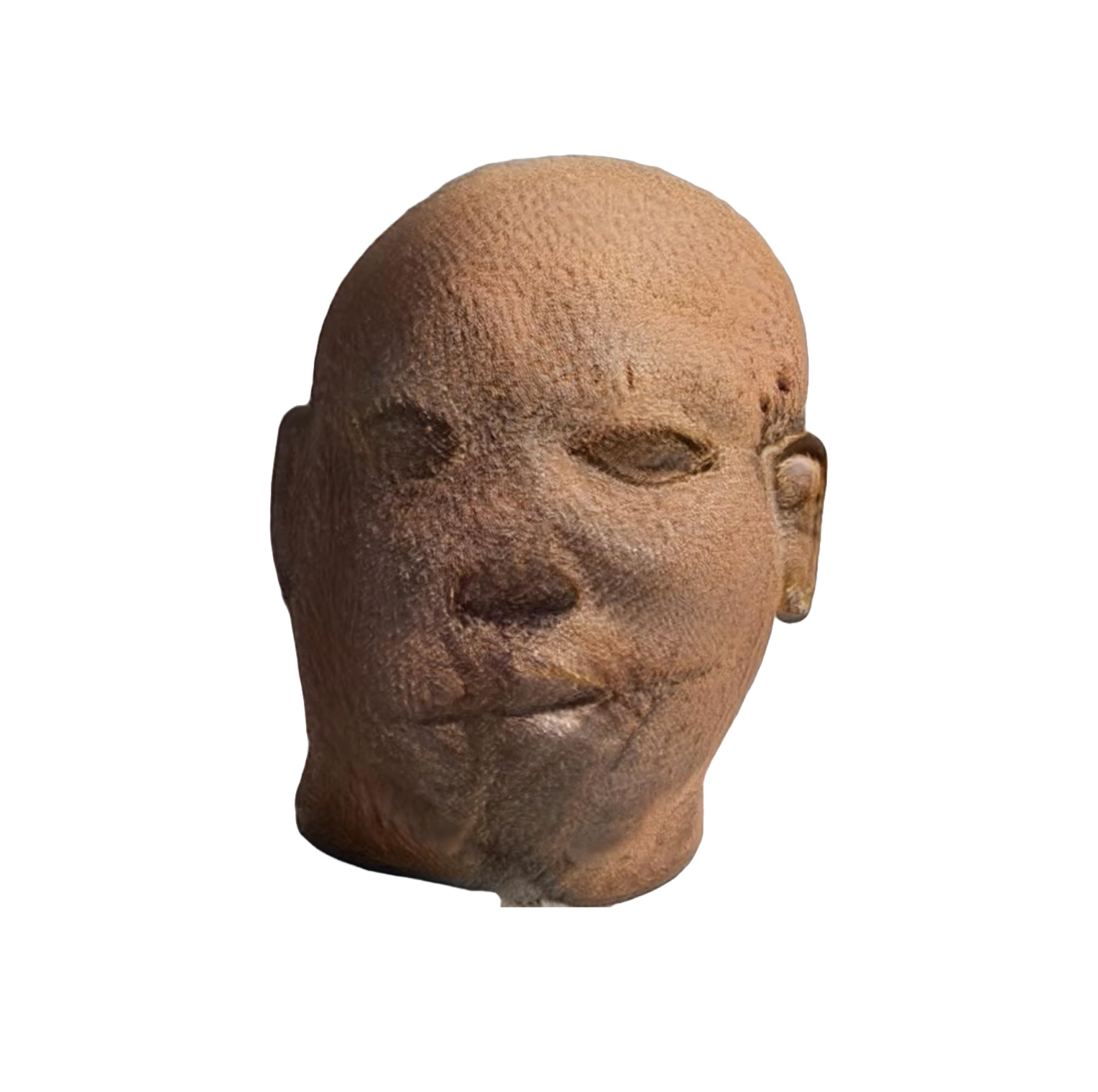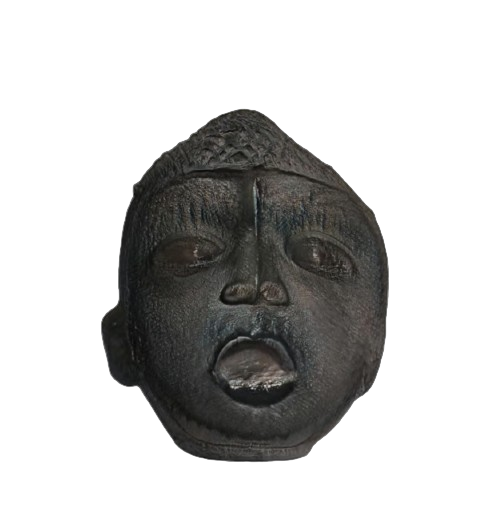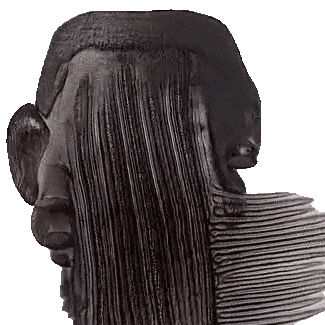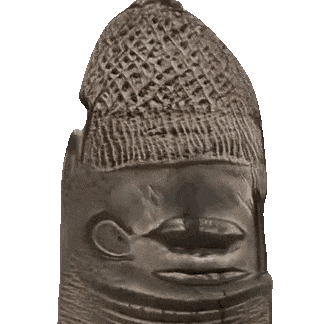I
On Seeing a Benin Mask in a British Museum (1977)
BY NIYI OSUNDARE
Here stilted on plastic
A god deshrined
Uprooted from your past
Distanced from your present
Profaned sojourner in a strange land
Rescued from a smouldering shrine
By a victorianizing expedition
Traded in for an O.B.E.
Across the shores
Here you stand, chilly,
Away from your clothes
Gazed at by curious tourists savouring
Parallel lines on your forehead
Parabola on your cheek
Semicircles of your eye brows
And the solid geometry of your lips
Here you stand
Dissected by alien eyes.
Only what becomes is becoming
A noose does not become a chicken’s neck
Who ever saw a deity dancing
langbalangba
To the carious laugh of philistine revelers?
Ìyà jàjèjì l’Ẹgbè
Ilé eni l’ẹ́só ye’ni
Retain the tight dignity of those lips
Unspoken grief becomes a god
When all around are alien ears
Unable to crack the kernel of the riddle.
II
DESHRINED ANCESTORS (2024)
BY MINNE ATAIRU
"Enough ivory may be found in the King's house" to finance the invasion of Benin Kingdom
[ I ].
The 1897 British invasion
of Benin was fueled by colonial intelligence reports
[ II ] that identified the
Kingdom's natural
and material
wealth
including sacred and secular objects made of bronze, wood, terracotta, ivory,
iron, coral, and leather. Armed with this knowledge, British soldiers razed the royal palace—a cultural
epicenter
that housed artist studios, residencies, and repositories of imported art materials. Amid the chaos, Oba
Ovonramwen-the Kingdom’s sole patron of the arts, was deposed and
exiled. The royal archive, rich with centuries-old artifacts, was looted and divided into
"official" and "unofficial" spoils. These looted artifacts, later termed "Benin Bronzes", were shipped
to England.
There, the "official booty of the expedition" was auctioned to "defray the cost of pensions" for the
colonial forces
[ III ]. A curator's 1898 ledger titled "Fate of the Benin
Bronzes" documents
their
distribution to
prominent institutions including the British Museum, Pitt Rivers Museum, Horniman
Museum
[ IV ].
Over a century later, these looted artifacts remain in the collections of 160
[ IV
] Western museums.
The 1897 colonial upheaval led to an exodus of artists from Benin city to satellite towns. In their new
homes, Benin artists were compelled to abandon their craft and take up subsistence farming. This period of
displacement marked the beginning of a 17-year artistic recession (1897-1914) for which no visual or
archival records have survived.
To address this dearth in archival documentation, I began a speculative project titled Igùn AI
[ V ]. The project
is
guided by two questions:
- What artifacts might have been
produced during the 17-year artistic recession?
- What alternative materials and artistic processes might displaced artists
have adopted?
In Igùn: Prototypes I—IX, I utilized StyleGAN2
[ VI ] , a machine learning
algorithm to
generate speculative images and videos. The process involved fine-tuning the algorithm
on a dataset of images depicting looted Benin Bronzes. While the speculative
outputs
provided invaluable insights into the aforementioned questions, the process also revealed two critical
limitations.
First, dimensionality: StyleGAN2 is designed for two-dimensional image synthesis. The model learns and
generates patterns solely on two-dimensional data, and therefore, lacks the capacity to
extrapolate those
patterns into three-dimensional forms. This constraint posed a challenge in rendering the spatial and
volumetric qualities that are integral to Benin’s sculptural tradition.
Second, materiality: StyleGAN2's learning process is heavily influenced by the characteristics of a dataset.
In
this case, I fine-tuned the model on a
dataset that primarily featured images representing bronze and terracotta objects. Consequently, the model
exhibited a bias towards these materials, which in turn, narrowed the scope of my material exploration.
The above outlined constraints have prompted the next phase of my research: a transition from
two-dimensional
to
three-dimensional generative models.
For centuries, Benin artists have
demonstrated mastery over three-dimensional forms—from classical sculptures depicting commemorative
portraits of
royalty and divinities to contemporary reproductions crafted for a tourist-driven market. This rich artistic
legacy demands a conceptual approach that fully honors and embodies the depth of three-dimensionality.
Advancements in text and image-conditioned 3D generative models have been instrumental in
overcoming the limitations of StyleGAN2. Models such as Rodin Diffusion
[ VII ]
enable the synthesis of
volumetrically and
geometrically
consistent three-dimensional graphics that better align with the material and spatial qualities of Benin’s
sculptural
tradition. My current research is driven by two questions:
- To what extent can I synthesize 3D structures that mirror the visual characteristics of the images
and videos generated for Igùn: Prototypes I—IX?
- To what extent can the synthesized 3D structures faithfully reconstruct the occluded
regions of the images and videos generated for Igùn: Prototypes I—IX?
My research questions are investigated and visualized through an augmented reality (AR) sculpture titled
"Deshrined
Ancestors" (2024). The digital sculpture is an assemblage of sixteen AI-generated artifacts
curated from
ten generations of foundational and fine-tuned machine learning models (2020-2024) developed for Igùn:
Prototypes I—X. The models utilized to address the challenge of dimensionality include:
I
Image Synthesis 2020-2022
StyleGAN2 models fine-tuned on a dataset of looted Benin Bronzes.
II
Text-to-Image 2021-2022
Text-guided image generation models fine-tuned on variations of the looted
Benin Bronze dataset.
III
Text-to-3D 2023
Three-dimensional models generated from text prompts.
IV
Image-to-3D 2024
Three-dimensional forms synthesized from two-dimensional images generated
with earlier models.
III
The Rubber Regulations of Benin (1898-1899)
To address the challenge of materiality, I imported my resulting AI-generated 3D-dimensional objects into
a 3D rendering engine that utilizes Physically Based Rendering (PBR)—a technique designed to simulate
various material properties under real-world conditions. Leveraging this approach, I
chose to simulate rubber—a malleable material that could plausibly have served as an alternative artistic
resource for displaced Benin artists.
Importantly, this material selection holds artistic significance when examined through the lens of
colonial-era
resource extraction
and exploitation in Benin.
The 1897 invasion of Benin drew attention to the region’s rubber
[ VIII ]
forests-a high-demand resource for the
production of industrial goods, such as hoses, tubes,
springs, washers, diaphragms. To maximize rubber extraction, colonial authorities implemented regulations
that
aggressively promoted rubber exploitation "to the utmost." These policies systematically dismantled Benin's
centuries-old land-use practices, including an eight-year fallow period,
permissionless farming on virgin land, and prohibition against farming in "evil/sacred forests" (Indigenous researchers have since explained that prohibitions against farming "evil/sacred forests" played a crucial role in forest conservation.
[
IX ]). To ensure compliance, colonial authorities offered £2 rewards to
informants who reported those still upholding precolonial land-use practices.
By 1899, colonial authorities had established 250 nurseries to cultivate rubber seedlings for the
development
of
"communal
plantations." These plantations expanded rapidly: from 126 in 1903, they expanded to 1,050 by 1906, 1,629 by
1907, and reached
2,251
by 1908
[ IX ].
European companies were also incentivized to exploit Benin’s rubber resources. For example, in
1905, Miller Brothers
acquired 500
acres for a rubber plantation and expanded by another 560 acres in 1911. By 1908, J.G.M Cranstoun and
Company owned two plantations covering 1,280 acres. By 1927, Messrs. MacIver Holdings controlled 2,021 acres
of rubber-producing land. Other companies involved in rubber exploitation included the Nigerian
Mahogany and Trading Company, MacIver and Palmer, United Africa Company, Bey and Zimmer, The African
Association, and The British Cotton Growing Association
[ X ].
Colonial records further underscore the magnitude of rubber extraction during this period. The "Annual
Report of the Colonies, Southern Nigeria" documented rubber exports of 2,251,315 lbs in 1900, 1,740,156 lbs
in 1901, 865,834 lbs in 1902, 1,656,000 lbs in 1907, and 713,000 lbs in 1908. These fluctuating figures
reflect the consequences of overexploitation and the subsequent decline in rubber yields
[ XI ].
The enforcement of these rubber regulations not only accelerated colonial extraction but also
criminalized
[ XII ] the indigenous population.
For
instance, in Regina v.
Osufu Jebu,
Sumola, and Bakari, the defendants were charged with smuggling "adulterated and very offensive" rubber. In
Regina v. Ground Nut, Jack, and Josiah, the accused were apprehended with "a lot of tools, etc., used for
working rubber." In Regina v. Thomas Ouami, the defendant was accused of leading a gang of illicit rubber
workers. Similarly, in Regina v. Ipapa, Ehenua, Obasuye, Asaota, and Jegede, the defendants were identified
as
members of a group of 150 illicit rubber tappers. Additional cases, such as Regina v. Gbeson and Aburonke,
Regina v. Adeanju, Regina v. Lawojo and Omoleye, Regina v. Akinbo, Regina v. Aluko, and Regina v. Jagbohun,
involved charges of "illicit rubber working" or "working rubber without a license."
While colonial-era rubber prosecutions are well-documented, much less is known about the lives of those
prosecuted. Among them could have been the very artists who once thrived under the Oba's
patronage. This uncertainty invites further speculation: Could some of these defendants have been displaced
artists? Artists who might have turned to full-time farming out of necessity? And if so, might they have
found ways to repurpose their "illicit" rubber tappings for artistic production?
VI
TECHNICAL NOTES
Deshrined Ancestors (2024) is a digital assemblage of sixteen AI-generated 3D artifacts curated from ten
generations of
foundational and fine-tuned machine learning models (2020-2024), developed for Igùn: Prototypes I—X. Each
artifact is labeled with a title (e.g., Prototype V), corresponding to its sequence across these ten
generations.
The piece is interactive in browsers and viewable in
Augmented Reality (AR) via mobile. The AR feature, exclusively available during exhibitions, overlays the 3D
sculpture onto a platform that
once housed a classical Benin Bronze at the RISD Museum from 1939-2020.
AR engine: model-viewer by Google.
Web Rendering: Three.js Mentor—a GPT developed by ThreeJS.
VI
REFERENCES
- Eyo, E. (1997). The dialects of definitions:" Massacre" and" sack" in the history of the Punitive
Expedition. African arts, 30(3), 34.
- Coombes, A. E. (1996). Ethnography, popular culture and institutional power: narratives of Benin
culture in the British Museum, 1897-1992.
- Read, C. H., & Dalton, O. M. (1898). Works of art from Benin City. The Journal of the Anthropological
Institute of Great Britain and Ireland, 27, 362-382.
- Eyo, E. (1997). The dialects of definitions:" Massacre" and" sack" in the history of the Punitive
Expedition. African arts, 30(3), 34.
-
See: institutional estimate according to a 2021 Global survey of Benin Bronzes via The Art Newspaper
- Atairu, M. (2024). Reimagining Benin Bronzes using generative adversarial networks. AI & SOCIETY,
39(1), 91-102.
- Viazovetskyi, Y., Ivashkin, V., & Kashin, E. (2020). Stylegan2 distillation for feed-forward image
manipulation. In Computer Vision–ECCV 2020: 16th European Conference, Glasgow, UK, August 23–28, 2020,
Proceedings, Part XXII 16 (pp. 170-186). Springer International Publishing.
- Wang, T., Zhang, B., Zhang, T., Gu, S., Bao, J., Baltrusaitis, T., ... & Guo, B. (2023). Rodin: A
generative model for sculpting 3d digital avatars using diffusion. In Proceedings of the IEEE/CVF
conference on computer vision and pattern recognition (pp. 4563-4573).
- Ikponmwosa, F. (2020). Colonialism and Industrial Development in Benin Province, Nigeria.
Romanian Journal of Historical Studies, 3(1), 20-29.
- Egboh, E. O. (1985). Forestry policy in Nigeria, 1897-1960. University of Nigeria Press.
- Fenske, J. (2013). “Rubber will not keep in this country”: failed development in Benin,
1897–1921. Explorations in Economic History, 50(2), 316-333.
- Southern Nigeria Annual Report for 1900.
